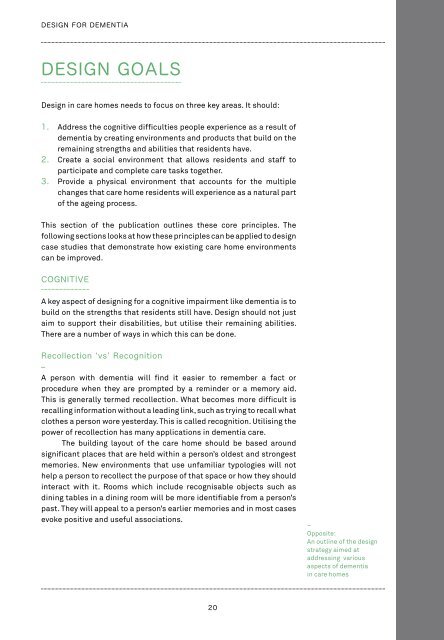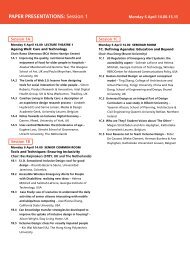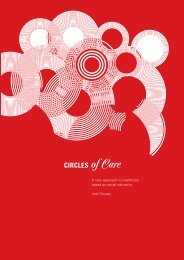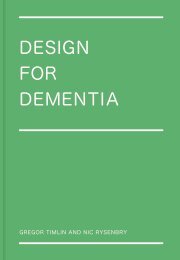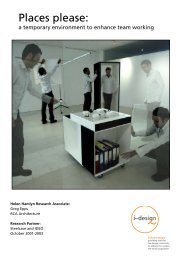Design for Dementia - Helen Hamlyn Centre - Royal College of Art
Design for Dementia - Helen Hamlyn Centre - Royal College of Art
Design for Dementia - Helen Hamlyn Centre - Royal College of Art
You also want an ePaper? Increase the reach of your titles
YUMPU automatically turns print PDFs into web optimized ePapers that Google loves.
DESIGN FOR DEMENTIA<br />
CONTEXT<br />
<strong>Design</strong> Goals<br />
<strong>Design</strong> in care homes needs to focus on three key areas. It should:<br />
1.<br />
2.<br />
3.<br />
Address the cognitive difficulties people experience as a result <strong>of</strong><br />
dementia by creating environments and products that build on the<br />
remaining strengths and abilities that residents have.<br />
Create a social environment that allows residents and staff to<br />
participate and complete care tasks together.<br />
Provide a physical environment that accounts <strong>for</strong> the multiple<br />
changes that care home residents will experience as a natural part<br />
<strong>of</strong> the ageing process.<br />
Recollection<br />
vs.<br />
Recognition<br />
Increased<br />
Dependence<br />
on the<br />
Senses<br />
Stress<br />
and<br />
Anxiety<br />
This section <strong>of</strong> the publication outlines these core principles. The<br />
following sections looks at how these principles can be applied to design<br />
case studies that demonstrate how existing care home environments<br />
can be improved.<br />
COGNITIVE<br />
COGNITIVE<br />
A key aspect <strong>of</strong> designing <strong>for</strong> a cognitive impairment like dementia is to<br />
build on the strengths that residents still have. <strong>Design</strong> should not just<br />
aim to support their disabilities, but utilise their remaining abilities.<br />
There are a number <strong>of</strong> ways in which this can be done.<br />
SOCIAL<br />
PHYSICAL<br />
Recollection ‘vs’ Recognition<br />
–<br />
A person with dementia will find it easier to remember a fact or<br />
procedure when they are prompted by a reminder or a memory aid.<br />
This is generally termed recollection. What becomes more difficult is<br />
recalling in<strong>for</strong>mation without a leading link, such as trying to recall what<br />
clothes a person wore yesterday. This is called recognition. Utilising the<br />
power <strong>of</strong> recollection has many applications in dementia care.<br />
The building layout <strong>of</strong> the care home should be based around<br />
significant places that are held within a person’s oldest and strongest<br />
memories. New environments that use unfamiliar typologies will not<br />
help a person to recollect the purpose <strong>of</strong> that space or how they should<br />
interact with it. Rooms which include recognisable objects such as<br />
dining tables in a dining room will be more identifiable from a person’s<br />
past. They will appeal to a person’s earlier memories and in most cases<br />
evoke positive and useful associations.<br />
–<br />
Opposite:<br />
An outline <strong>of</strong> the design<br />
strategy aimed at<br />
addressing various<br />
aspects <strong>of</strong> dementia<br />
in care homes<br />
Prospective<br />
Memory<br />
Doing<br />
Tasks<br />
Together<br />
Sight<br />
Mobility<br />
20<br />
21


